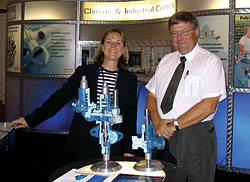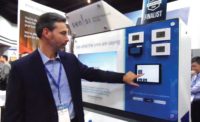
What it lacks in size, the Mexico expo makes up in status. All the big names were here, including Trane, Carrier, Lennox, Rheem, and York, along with numerous other companies. Some displayed products specifically for the Mexican and Latin American markets.
Developed exclusively for the growing HVACR markets in Mexico and Latin America, AHR Expo-Mexico showcases the latest HVACR equipment, systems, and components from leading manufacturers from the United States, Mexico, and around the world.
Many manufacturers from the United States said they were excited to be at AHR Expo-Mexico because they wanted to show their dedication to the growing Mexican-Latin American market. As such, many exhibitors focused on name brand recognition rather than actual products at the show.

Different Venue, Different Goals
Cheryl Aderhold, marketing communications coordinator for Greenheck (www.greenheck.com), noted, "It's important for us to be here at the expo in order to build awareness for our products in this market." Greenheck doesn't exhibit at the AHR Expo in the United States, relying instead on its 53-foot trailer, which showcases the company's most popular ventilation equipment. This traveling showcase gives the manufacturer the opportunity to bring its services and products directly to engineers and contractors across the country.Emerson Climate Technologies (www.emersonclimate.com) international sales manager John McDaniel said the company was at this show to demonstrate the company's shift in philosophy. "Our separate divisions such as Copeland and White-Rodgers are talking to each other more, and there's more cross-pollination. We're making it easier for big business to work with us."
Bill Steel at Bard (www.bardhvac.com) said the company feels it is important to have a booth at the show because of its growing market share in Mexico. "Since 2000 we've had a plant in Saltillo, and now more than 90 percent of our coils are made in Saltillo," he said. "We have a lot more exposure in the Mexican market now."
By participating at the AHR Expo-Mexico, Tom Kacich of Westinghouse (www.westinghousehvac.com), a Nordyne company, said the company is promoting awareness of the Westinghouse brand and highlighting its products.
Parker Hannifin's (www.parker.com) Eric Graebert said this was the company's fourth time at AHR Expo-Mexico. "Our business is expanding rapidly in Mexico," he said. "It's important for us to be at these shows."
William Merritt Jr., Tecumseh (www.tecumseh.com) vice president of marketing and sales, North America, noted that the company is very focused on being a solutions provider, which is why the divisions of the company (including Little Giant and FASCO) are working closely together. All divisions of the company were in evidence in the booth.
Sporlan Valve Co. (www.sporlan.com) export sales manager David Hoffman said the company reaches a lot of service people and installers at AHR Expo-Mexico. "We have two Mexican sales engineers here, and the expo gives them an opportunity to talk with their customers face-to-face. We also want to highlight the fact that we've translated all our literature into Spanish, which customers definitely appreciate."
Rheem (www.rheemac.com) vice president William Lux noted that electricity is very expensive in Mexico, so efficiencies are important. "People want higher-SEER products, because electricity can be as much as $0.25 kWh. Utilities often offer incentives on products to help."
"We made an all-out effort last year in Mexico for the commercial market. We've hired a full-time territory manager in Mexico, so we're here to let contractors know about our rooftop units," said Christine Lau of Lennox (www.lennox.com).
Carlyle Compressor (www.carlylecompressor.com) came to the expo in order to show the company's commitment to the market. Spokesperson Tommy Gaubatz stated that in the last two years, Carlyle has worked with Carrier Totaline, focusing on compressor remanufacturing in Mexico. "We use direct sales, which allows us to stay connected to the Mexican market, but for the aftermarket, we rely on Totaline."

Exhibitor Highlights
Greenheck showcased its Model Axial ventilation fans. These wall-mounted fans are designed for air movement in restricted spaces, process cooling in small areas, and other applications where quiet, high-capacity ventilation is needed. Available in three sizes, the axial is typically used for open-air ventilation of bathrooms through short duct lengths.The company also highlighted its Model TCB-LE and Vector laboratory exhaust systems. The TCB-LE is a self-contained laboratory exhaust system geared toward the school market. Laboratory fumes are accelerated to high velocity, giving the exhaust additional momentum to be displaced high above the roof. The Vector system is designed for larger pharmaceutical applications.
Emerson had an extensive booth, which highlighted the company's Copeland compressors and White-Rodgers thermostats. Spokesman Fernando Pujalt noted, "We're moving away from the focus on individual products and instead we're focusing on solutions." McDaniel noted that Emerson has made it easier for contractors, too, by retooling its Web site. "The Web site is especially for contractors. It helps them with training and materials, which makes their jobs easier."
Westinghouse used its booth to launch the brand name in Mexico. Kacich stated that the company is switching over from the Miller and Intertherm brand names in Mexico to Westinghouse. "The Westinghouse name has always stood for quality, so we think the transition in the Mexican market will be met positively."
Mini-split systems are very popular in Mexico. Westinghouse has a line of mini-splits and ceiling cassettes, which Kacich says are more aesthetically pleasing.

The company also highlighted its E4FS electronic liquid valve and E4VS electronic pressure regulator. Designed for industrial ammonia refrigeration systems, these components are primarily targeted toward liquid-feed and pressure-regulating applications.
Tecumseh highlighted its ability to provide total solutions for customers. Merritt said the company is promoting choices and a full line of solutions. The company's complete refrigeration systems were prominently on display. These are designed to reduce operating costs, especially in the area of inventory, order processing, and manufacturing.
Rheem featured many of the same products available in the U.S. market, including its new Classic line of heating-cooling products. Rheem has introduced its own line of mini-splits to the Mexican market. These have been available for approximately three months.
Sporlan highlighted its service kits for contractors in the field. Jason Boles said the kits have mix-and-match components in either the standard Q case or balanced-port BQ case to satisfy more than 100 TEV applications. The kits are equipped with valve bodies, thermostatic elements, and a cartridge service kit, which will work for most refrigerated cases, coolers, and freezers.
Lennox said it already sells a great deal of residential equipment in Mexico, but it was using the expo as an opportunity to highlight its L-Series rooftop units for commercial applications. Lau said Mexico is a beautiful market for rooftop units because of the wide variety of temperatures experienced throughout the country.
All Carlyle's literature has been translated into Spanish. Gaubatz noted, "We're here to show customers we are dedicated. We are sensitive to this market's needs, so it's important to demonstrate our significant commitment."
Sidebar: Doing Business In Mexico - It's The Same, But Different
U.S. manufacturers like doing business in Mexico for a number of reasons.1. It's close to the United States geographically.
2. Products don't need to be made differently for this market. Unlike Europe and Asia, Mexico shares the same voltage and electrical configurations as the United States.
Monterrey in particular seems similar to the United States in many respects. For example, American dollars are accepted everywhere and American companies from Kraft to Whirlpool line the freeway from the airport into town. Quite a few people speak English, and indeed, many of the signs around town are in English.
Many manufacturers at AHR Expo-Mexico said doing business in Mexico and Latin America is similar to doing business in the United States, but there are some very important differences. Eric Graebert of Parker-Hannifin noted that relationships are probably more important in Mexico. "It's very important who you know in Mexico, as sales are made based on relationships. Who you know is more important than price. Basically, Mexican companies like to deal with other Mexican companies."
Graebert also said reliability and interchangeability are extremely important. "You don't want to introduce a radical new concept in this market. You have to make something that looks exactly like the competitor's, but is better and cheaper."
Surprisingly, many exhibitors at AHR Expo-Mexico do not manufacture their products in Mexico. They rely on Mexican distribution networks in order for their products to reach the end user. Getting the product into Mexico isn't a problem either, as many manufacturers have their plants just over the border in Texas or other southern states. This is particularly important for OEM customers, who demand just-in-time inventories.
At AHR Expo-Mexico, one of the most surprising differences was the fact that people were smoking just about everywhere. In fact, exhibitors routinely lit up cigarettes while talking with customers.
As can be expected, the biggest difference was the language barrier. A number of booths had no personnel who spoke English at all. That's not entirely surprising, because the show was in Mexico. However, it was even true at some booths of American companies that have plants in Mexico. This goes to show that many companies are taking their place in the Mexican market very seriously - speaking the language and becoming part of the culture.
- Joanna Turpin
Publication date: 10/11/2004





